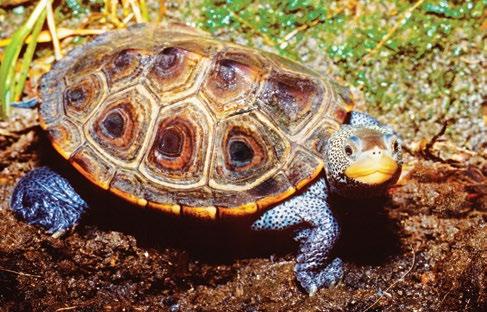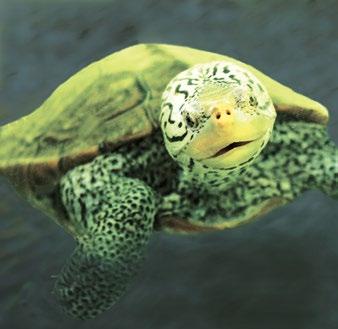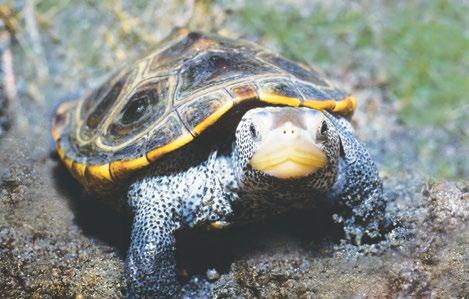
3 minute read
A Diamond in our Estuaries
From below the warming spring waters of a Delaware estuary, a diamondback terrapin raises its head from the confines of its shell. It stretches its legs to free itself from its mud shelter, where it spent the winter in hibernation. With a few strokes of its fully extended legs and web feet, the creature’s snout breaks the surface for a long-awaited breath of fresh air. Then, as it swims away, a small wake in the marsh creek is often the only thing that reveals its presence.
restricted to brackish water (more salty than fresh but less salty than sea water) environments. Its habitats include coastal marshes, tidal creeks, mudflats and back bays, or bodies of water that lie behind barrier beaches.
Advertisement
Adult male terrapins average no more than 5 inches in length while females can attain a length of almost 10 inches. Males reach sexual maturity between 4 to 7 years; females do so at about 8 to 13 years. The species life span may exceed 40 years.

As the waters warm under the early summer sun, mating takes place at or
By Bob Bachand, Author of Coastal Atlantic Sea Creatures: A Natural
History
The terrapin begins its winter hibernation when the marsh’s waters dip down to about 45 to 50°F. Some of the turtles choose to hibernate alone, while others do so in small groups. They can take refuge under a thin layer of mud, beneath undercut banks or bury themselves at the top of a creek bank. During a winter thaw, some re-emerge for a short time only to return to hibernation as the temperature dips once again.
Along the Atlantic and Gulf coasts, the diamondback is the only species of turtle that is entirely near the surface, ordinarily during daylight hours. A short time later (mid-June through July, New Jersey to Maryland), a female, laden with eggs, swims parallel to the shoreline. When the tide nears its peak, she clambers up a sand beach and moves away from the water’s edge. In selecting a site for her nest, she probes the sand with her snout. When satisfied, she begins to dig with her front feet. At some point, she moves slightly forward and continues digging with her hind legs. In the process, she creates a triangular-shaped nest to a depth of 4 to 8 inches. She then stands over her nest and deposits 4 to 18 pinkish-white, thin, leathery eggs. As each egg is laid, she covers it with a little sand. When completed, she covers the remaining portion of the nest entirely with sand, pats it down until it is nearly flat, and then abandons her developing embryos to the mercy of nature. The eggs incubate over the next 60 to 104 days. Investigators have found that in nests whose temperatures are maintained at about 78°F, all of the young hatched as males; with nest temperatures maintained at about 90 ºF, all of the hatchlings are females. Nest predation can be devastating. Crows and gulls dig up nests to get after the eggs; raccoons, muskrats, skunks and others attack the hatchlings. Together, predators have been known to destroy 50 to 70% or more of the brood.
Hatchlings generally emerge from their nests during daylight hours, one or more at a time, over a period of 1 to 9 days.
The 1- to 3-inch-long turtles avoid open water. Instead they head for clumps of marine vegetation lying on the beach. Taking refuge there, they feed on insects, amphipods, tiny fiddler crabs and other

Thank You!
“invertebrates,” or spineless critters within their reach. Some investigators, however, feel that the creatures don’t even feed in the autumn of their first year. As our area waters cool, they bury themselves in the mud bottoms of tidal creeks where they hibernate over the winter. Adult terrapins feed on juvenile crabs, snails, clams, fish, insects and plant material.
Historically, diamondback terrapins were highly sought for their meat. Between the 1880s and 1930, the species was nearly wiped out. Though their numbers have recovered, those caught in crab traps drown if the trap is not checked daily. Automobiles account for the loss of many females as they attempt to cross roads to reach nearby nesting grounds. In New Jersey, as many as 267 female terrapins, in a single season, ended up as “road kills.” If you should see one crossing the road, and can safely come to a stop, pick up the turtle and carry it over to the other side. Alterations in habitat can also have a major impact on them. Bulkheads and riprap can prevent access to their remaining nesting sites. In some cases, the introduction of beach grasses can also be detrimental. As the grasses quickly invade enough of the open, sandy beaches, they can affect the sand temperature and moisture, thereby altering the sex of the hatchlings. ■
The Partnership for the Delaware Estuary would like to thank the attendees, presenters, and sponsors of the 2015 Delaware Estuary Science & Environmental Summit. Congratulations to our student award winners, Kurt Cheng of Drexel University and Thomas Santangelo of the University of Delaware. Watch for articles detailing their research in future issues of Estuary News.
Did You Know?
A bill (S2615) introduced in the New Jersey Senate last year proposed to make it illegal to catch or take diamondback terrapins, among other protections. This is already illegal in Delaware, where they are listed as a species of concern.




